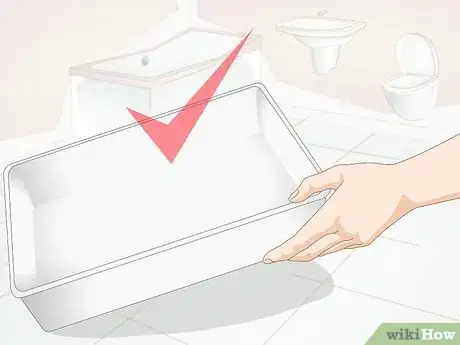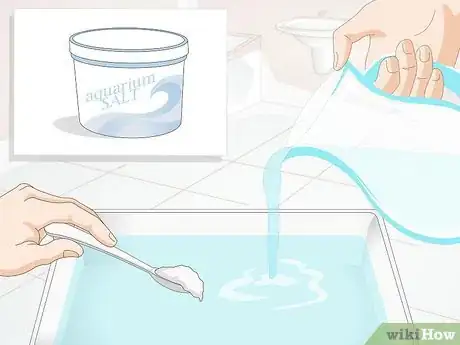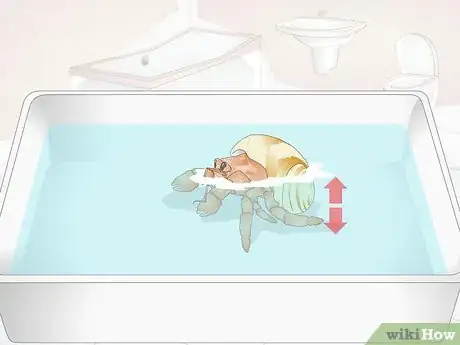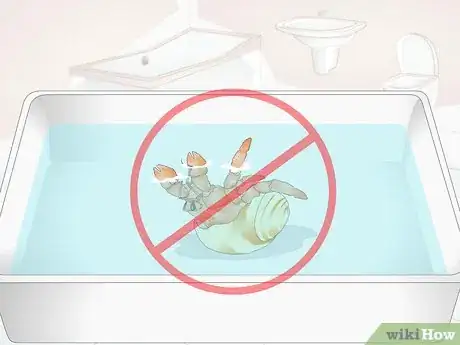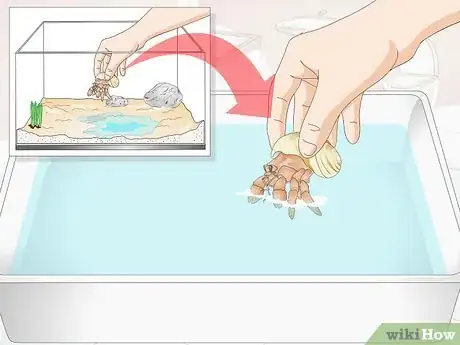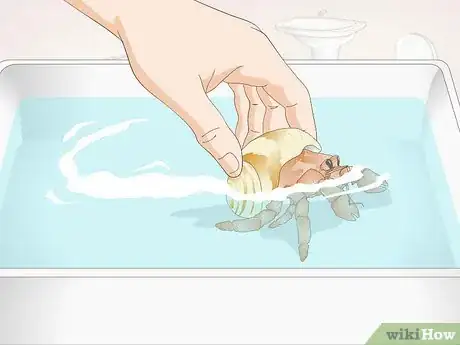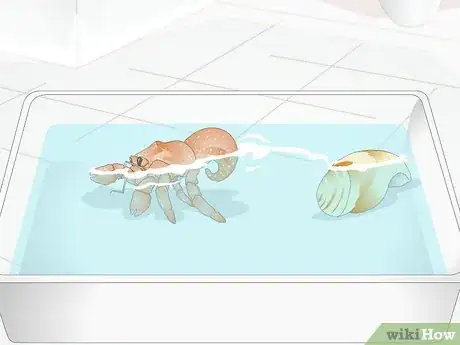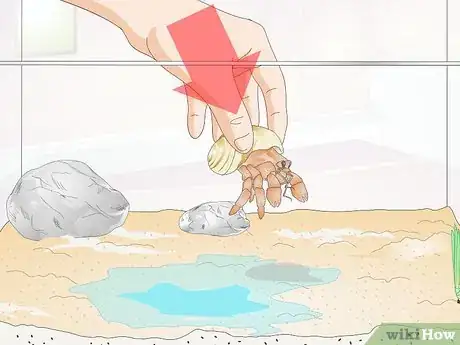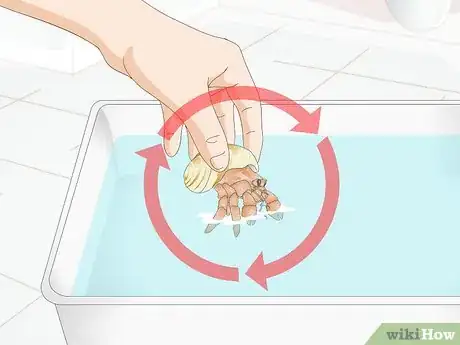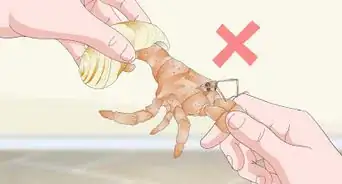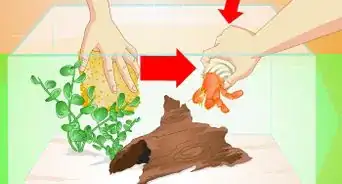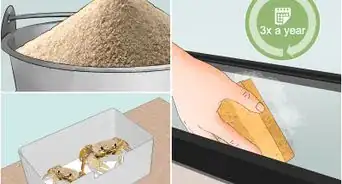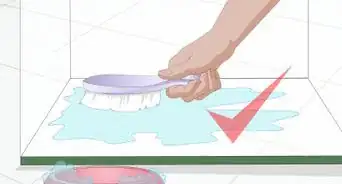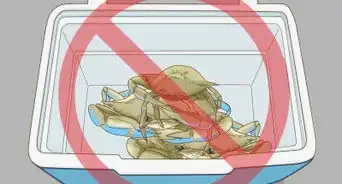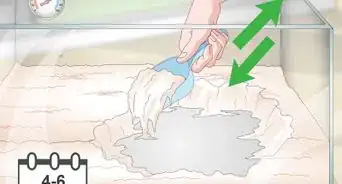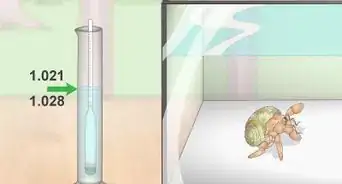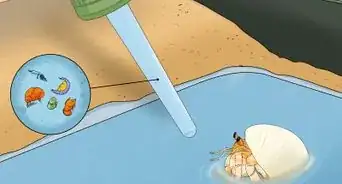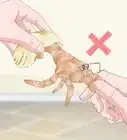This article was co-authored by wikiHow Staff. Our trained team of editors and researchers validate articles for accuracy and comprehensiveness. wikiHow's Content Management Team carefully monitors the work from our editorial staff to ensure that each article is backed by trusted research and meets our high quality standards.
wikiHow marks an article as reader-approved once it receives enough positive feedback. This article received 30 testimonials and 88% of readers who voted found it helpful, earning it our reader-approved status.
This article has been viewed 355,848 times.
Learn more...
Hermit crabs require exposure to salt water to keep them healthy and happy, but you may not want to keep a salt water bowl in their tank in addition to their freshwater drinking bowl. In that case, you should give your hermit crab regular baths to keep it clean and free from mites. Salt water baths also help hermit crabs replenish the water they store in their shells, which they use to keep their bodies moist and hydrated.[1]
Steps
Preparing the Bath
-
1Find the right container. You can use just about any bowl or small container to serve as a hermit crab bath if you intend to help the crab bathe itself. If you are going to keep a hermit crab bath inside the tank, you may want to use a small water bowl designed for pets in tanks to ensure the crab can enter and exit the water easily.[2]
- Choose a bowl with a flat bottom so the crab can easily maneuver while in its bath.
- If you will not be present as your crab bathes, ensure it is able to easily get out of the water.
- Hermit crabs can knock over light bowls, so if you leave a bowl in the tank, ensure it is heavy enough that the crab can’t knock it over.
-
2Create a salt water mixture. Hermit crabs drink freshwater, but need to be bathed in a salt water solution. There are a number of products available for sale at your local pet store to help you add the right kind of salt to your water.
- Products like Hermit Crab Salt or Oceanic Salt provide the right sort of salt content for your hermit crab bath.
- Use distilled, room temperature water instead of tap water to ensure there are no chemicals that could harm your hermit crab in the water.
- Use one teaspoon of salt per every one hundred milliliters of water for the best mixture.
Advertisement -
3Fill the container to the correct level. Once you have your container and your salt water mixture, you will need to fill the container to the correct height to serve as a hermit crab bath without putting the crab at any risk.
- Do not fill the container so the hermit crab would be completely submerged in water, instead make it so the top of the water will be just below the top of the hermit crab’s shell.
- If you are keeping the crab bath in the tank, make sure there are pebbles in it and a way to exit the water so the crab does not end up trapped in the container.
-
4Be careful not to let your hermit crab drown. Hermit crabs love a good bath, but don’t forget that they are land crabs and require oxygen to breath. Keeping the crab submerged in its bath for too long could kill a hermit crab.[3]
- Do not leave the hermit crab unattended in the bathing container if you are bathing your crab separate from its tank and it is unable to climb out of the container on its own.
- Only keep your hermit crab in the water for a few minutes, then return it to its tank.
Bathing Your Hermit Crab
-
1Remove your crab from its tank and place it in the bath. Be gentle when removing your hermit crab from its tank to avoid stressing the crab out too much. Use slow movements when approaching the crab and don’t make sudden movements while you are holding it.[4]
- Taking your crab out of its tank too often can stress the crab out and cause it to retreat to inside its shell for extended periods of time.
- Try to make the process a pleasant one for the crab by being gentle and slow moving.
-
2Move the crab around a bit once it’s in the water. Once you place the crab down into the salt water solution, it may be too afraid of the process to recognize that it is now in a salt water bath it will really enjoy.[5]
- Swish the crab around a bit so the water in the container comes into contact with the crab’s legs and splashes into the shell to make sure it understands that it is in the water.
- Leave the hermit crab alone for a minute after to allow it to come out of its shell.
-
3Allow your crab to come out of its shell and move around. After a minute or two the crab will begin to emerge from its shell and crawl around in the container. Allow it to move around freely as it bathes itself and replenishes the water in its shell it uses to stay moist.[6]
- Let the crab explore the container and move about freely as it cleans itself.
- Don’t leave the crab in the water for too long. Allow it to crawl around for a few minutes, then remove it when it either seems like it is trying to find a way out or recedes back into its shell.
-
4Return your clean hermit crab to its tank. If you do not leave a bathing bowl in your hermit crab’s tank, you will need to return it to its home now that it’s nice and clean. Be careful not to frighten or stress out your crab in the process.
- You may want to allow your crab to crawl around on a paper towel first to dry off a bit.
- Be gentle as you remove the crab from its bath and return it to its tank.
- Do not bath your crab more frequently than once per day, as otherwise it may become stressed out and refuse to leave its shell.
-
5Be sure to bathe your hermit crab as needed. Hermit crabs require frequent baths in salt water in order to maintain their health, but there are some variables that may affect how often your hermit crab needs a bath.[7]
- Hermit crabs require bathing daily if the humidity levels in the habitat of the crab are less than 70%.
- If the crab lives in a habitat that maintains higher than 70% humidity, bathing may be infrequent and sporadic, as the moisture levels in the air will enable to crab to maintain proper moisture levels in its skin.
- Regardless of humidity level, bathe your hermit crab if you notice mites or small insects crawling around on your crab.
Community Q&A
-
QuestionHow are some ways I can get my hermit crabs to trust me? Every time I go to take them out, they hide out in their shells and never come out. I also can't get them to play, and I don't have the salt.
 Community AnswerYour hermit crabs might need some time to adjust to their surroundings. They may be stressed out because they are in an unusual habitat. Try to leave them alone for some time until you see that they have adapted to the new environment. Also make sure that you do get the salt for the the crabs from the pet store.
Community AnswerYour hermit crabs might need some time to adjust to their surroundings. They may be stressed out because they are in an unusual habitat. Try to leave them alone for some time until you see that they have adapted to the new environment. Also make sure that you do get the salt for the the crabs from the pet store. -
QuestionWhat if a hermit crab stays in the ground for a few days and does not change shells?
 Community AnswerYour hermit crab is most likely molting. Keep an eye on him.
Community AnswerYour hermit crab is most likely molting. Keep an eye on him. -
QuestionWhat do you do if your crab won't get back in its shell?
 Community AnswerLeave it alone. He may need a new shell; his could be damaged in some way, or be too small.
Community AnswerLeave it alone. He may need a new shell; his could be damaged in some way, or be too small.
References
- ↑ http://www.hermit-crabs.com/care.html
- ↑ http://www.hermit-crabs.com/care.html
- ↑ http://www.hermit-crabs.com/care.html
- ↑ http://www.hermit-crabs.com/care.html
- ↑ http://www.hermit-crabs.com/care.html
- ↑ http://animals.mom.me/set-up-salt-bath-hermit-crab-6009.html
- ↑ http://www.hermit-crabs.com/care.html
About This Article
To give your hermit crab a bath, start by combining water and Oceanic Salt, which you can buy from a pet store. Then, remove your crab from its tank and put it in the bath. Next, swish the water around so it goes into the crab's shell, which will encourage it to come out. Once the crab comes out of its shell, allow it to crawl around in the container and replenish the water in its shell. After a few minutes, remove your crab from the bath and place it back in its tank to keep it from drowning in the salt water. To learn more, like how often you should bathe your crab, read on!
